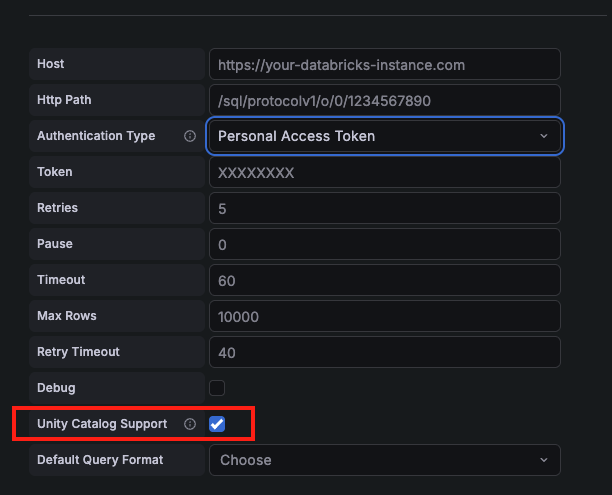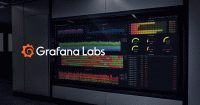Databricks query editor
Grafana provides a query editor for Databricks data source, which is located on the Explore page. You can also access the query editor from a dashboard panel. Click the menu in the upper right of the panel and select Edit.
This document explains querying specific to the Databricks data source. For general documentation on querying data sources in Grafana, refer to Query and transform data. For options and functions common to all query editors, refer to Query editors.
The Databricks query editor has two modes:
To switch between the editor modes, select the corresponding Builder and Code tabs in the upper right.
Warning
When switching from Code mode to Builder mode, any unsaved changes to your Databricks query are lost and won’t appear in the Builder interface. You can either copy the code to your clipboard or discard your changes before switching.
To run a query, select Run query in the upper right of the editor.
In addition to writing queries, the query editor also allows you to create and use:
Builder mode
Builder mode allows you to build queries using a visual interface. This mode is great for users who prefer a guided query experience or are just getting started with Databricks SQL, which is based on Apache Spark SQL. For more information on Databricks SQL, refer to the SQL language reference in the Databricks documentation.
The following components will help you build a Databricks SQL query:
- Format - Select a format response from the drop-down for the Databricks query. The default is Table. Refer to Table queries and Time series queries for more information and examples. If you select the Time series format option, you must include a
timecolumn. - Filter - Toggle to add filters.
- Filter by column value - Optional. If you toggle Filter you can add a column to filter by from the drop-down. To filter by additional columns, click the + sign to the right of the condition drop-down. You can choose a variety of operators from the drop-down next to the condition. When multiple filters are added, use the
ANDorORoperators to define how conditions are evaluated.ANDrequires all conditions to be true, whileORrequires any condition to be true. Use the second drop-down to select the filter value. To remove a filter, click the X icon next to it. If you select adate-typecolumn, you can use macros from the operator list and choosetimeFilterto insert the$\_\_timeFiltermacro into your query with the selected date column. - Group - Toggle to add a
GROUP BYcolumn. - Group by column - Select a column to filter by from the drop-down. Click the +sign to filter by multiple columns. Click the X to remove a filter.
- Order - Toggle to add an
ORDER BYstatement. - Order by - Select a column to order by from the drop-down. Select ascending (
ASC) or descending (DESC) order. - Limit - You can add an optional limit on the number of retrieved results. Default is 50.
- Preview - Toggle for a preview of the SQL query generated by the query builder. Preview is toggled on by default.
- Schema - Select a schema from the drop-down. The schema is a logical container that organizes and groups related database objects like tables, views, and functions within a catalog. It forms part of Databricks’ three-level namespace hierarchy: catalog.schema.table.
- Table - Select a table from the drop-down. Table selection is dependent on schema.
- Column - Select a column from the drop-down. A column is a named field within a table that holds data of a specific data type. You can select multiple columns.
- Aggregation Optional. Select an aggregation type from the drop-down. Databricks SQL supports an extensive variety of aggregation types,including specialized aggregations. You can select multiple aggregations.
Code mode
Use Code mode to build complex queries using a text editor with helpful features like syntax highlighting, autocompletion, and support for macros. This mode is ideal when you need to write subqueries, apply advanced filtering, or use SQL constructs that the visual builder may not support.
You can switch back to Builder mode, but some parts of your query, such as custom SQL, macros, or non-standard clauses, may not render correctly or be editable in the visual interface.
Unity Catalog support
Enabling Unity Catalog support allows Grafana to connect to Databricks Unity Catalog and display available catalogs directly in the query editor. You enable Unity Catalog support when configuring the Databricks data source. When this option is enabled, the Schema drop-down is replaced with a Unity Catalog drop-down that lists all available schemas within each catalog. This enables you to query data using the full three-level namespace format: catalog.schema.table.
For more information, refer to What is Unity Catalog? in the Databricks documentation.
Note
To use Unity Catalog in Grafana, your Databricks credentials must have the necessary workspace permissions. Verify that your authentication token or user account can access the catalogs, schemas, and tables you plan to query.
Enable Unity Catalog
To enable Unity Catalog support in your Databricks data source:
- Navigate to your Databricks data source configuration page.
- Under the connection settings, find the Unity Catalog Support checkbox.
- Enable the checkbox to activate Unity Catalog features.
- Click Save & Test to verify the connection.

Unity Catalog example query
Following is a basic example query using the Unity Catalog hierarchical three-level namespace:
SELECT *
FROM mycatalog.myschema.mytable
LIMIT 100;You can also use Grafana macros and variables in your queries. For example, to filter by the dashboard time range:
SELECT
event_time AS time,
user,
action
FROM mycatalog.myschema.mytable
WHERE $__timeFilter(event_time)
ORDER BY event_time DESC
LIMIT 500;Table queries
To create a Table query, set the Format option in the query editor to Table. This mode lets you to write any valid Databricks SQL query, The Table visualization then displays the results as rows and columns, exactly as returned by the query.
Example query:
SELECT
order_date,
customer_id,
product_name,
quantity,
unit_price,
(quantity * unit_price) AS total_amount
FROM sales.orders
WHERE order_date >= '2022-01-01'
ORDER BY order_date DESC
LIMIT 100This query retrieves the 100 most recent orders placed on or after January 1, 2022.
It returns each order’s date, customer ID, product name, quantity, unit price, and calculates a total_amount column by multiplying quantity by unit_price.
Grafana displays these results as a table, allowing you to sort, filter, or transform the data directly within the panel.
Time series queries
To create a Time series query, set the Format option to Time series. Your query must include a datetime field (ideally aliased as time), which Grafana uses as the timestamp column. Grafana interprets timestamp values without an explicit time zone as UTC, and all columns except the time column are treated as value columns.
Example:
SELECT
event_time AS datetime,
COUNT(*) AS total_events
FROM events
WHERE event_time BETWEEN $__timeFrom() AND $__timeTo()
GROUP BY event_time
ORDER BY event_timeThis query returns the total number of events that occurred over time.
It counts all rows in the events table for each timestamp within the Grafana dashboard’s selected time range.
The macros $__timeFrom() and $__timeTo() automatically substitute the start and end times from the dashboard’s time picker.
Multi-line time series
To create multi-line time series, the query must return at least three fields in the following order:
- field 1:
datetimefield with an alias oftime - field 2: value to group by
- field 3+: the metric values
Example:
SELECT log_time AS time, machine_group, avg(disk_free) AS avg_disk_free
FROM mgbench.logs1
GROUP BY machine_group, log_time
ORDER BY log_timeThis query returns the average disk space available (avg_disk_free) over time for each machine_group.
Grafana uses the time column for the x-axis, and creates a separate line for each distinct machine_group value.
Each line shows how the average free disk space changes over time for that specific group.
Macros
The Databricks data source includes built-in macros that simplify working with time-based queries. These macros automatically expand into SQL expressions when your queries run, enabling you to build dynamic queries that respond to dashboard time ranges and interval controls.
Use these macros to filter data by the dashboard’s selected time range, group results by dynamic time intervals, and create time series visualizations that automatically adapt to different time periods. Just include the macro syntax in your SQL query, and Grafana handles the rest by replacing each macro with the appropriate SQL code based on your current dashboard settings.
$__interval_long macro
The $__interval_long macro converts Grafana’s dashboard interval into a Spark SQL-compatible INTERVAL format, making it easy to use with Spark SQL window functions.
Example query:
SELECT window.start, avg(aggqueue) FROM a17
GROUP BY window(_time, '$__interval_long')This query calculates the average of aggqueue values grouped into time windows. The window() function creates time-based buckets using the _time column, with the bucket size determined by the $__interval_long macro. The window size automatically adjusts based on your dashboard’s interval setting, allowing the same query to work across different time ranges and zoom levels.
Expanded query (when the dashboard interval is set to 2 minutes):
SELECT window.start, avg(aggqueue) FROM a17
GROUP BY window(_time, '2 MINUTE')In this expanded version, Grafana replaced $__interval_long with 2 MINUTE, creating 2-minute time buckets. Each bucket contains the average aggqueue value for that 2-minute period, with window.start providing the timestamp for when each bucket begins.
Macro expansion reference:
The macro converts any Grafana interval (like 30s, 5m, 1h, or 1d) into the appropriate Spark SQL interval format (30 SECOND, 5 MINUTE, 1 HOUR, 1 DAY). This ensures your queries remain compatible with Spark SQL’s interval syntax regardless of how users interact with the dashboard’s time controls.



